So here I was, last spring, talking away with the recently-departed Marcel Lapierre, the Beaujolais vigneron who was one of the dominant figures of the natural wine movement in its strictest definition—organic in the vineyard, wine made with grape juice only, nothing added (not even sulfur), nothing taken out. And as we got into discussing the risks of wild fermentations without sulfur, I asked him what he recommended doing if a fermentation went off in the wrong direction, with undesirable microorganisms like Brettanomyces taking over the wine’s development.
“You could add sulfur,” he said, matter-of-factly.
If it’s that or losing the wine, he pragmatically pointed out, why would you hesitate?
This kind of no-nonsense attitude, stated with a wise and calm smile, was quite clearly present in all of Lapierre’s discourse, and those of the other Beaujolais natural wine producers that came along with him to Quebec, last spring, to showcase their latest vintages. Jean and Agnès Foillard, Christophe Pacalet and Georges Descombes also showed a very practical take on natural winemaking, putting the accent on plant physiology and careful use of microbiology, rather than, say, flying stones or root vs. leaf days.
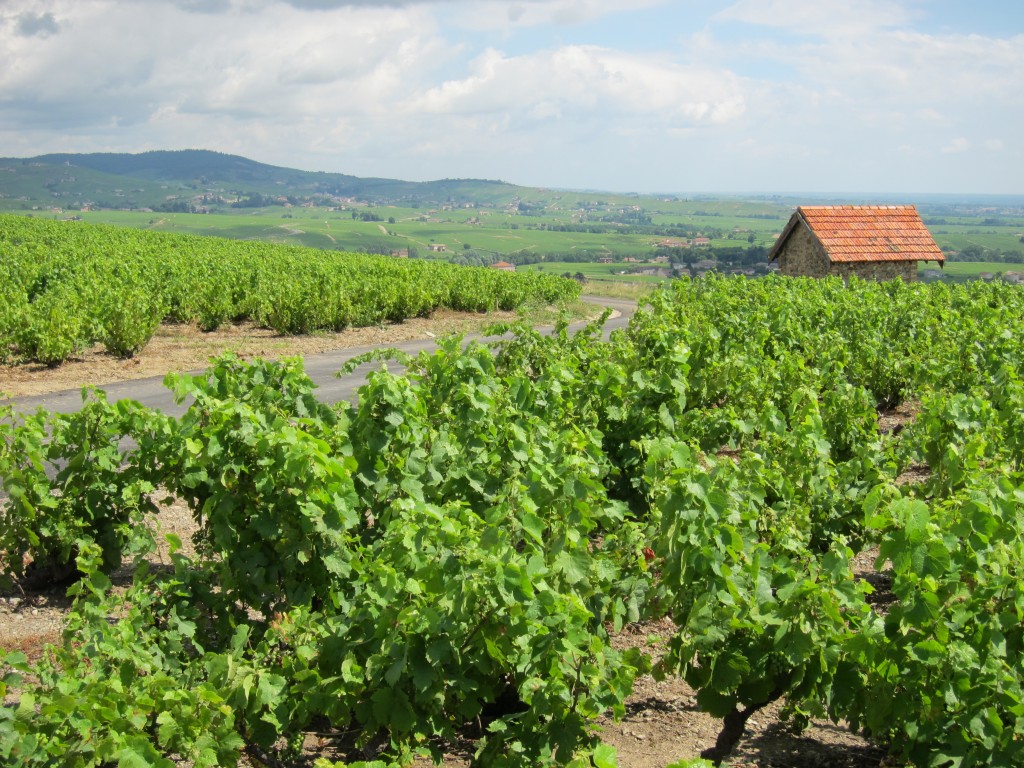
- Vineyards on the Côte du Py, in Morgon, the Beaujolais cru that has also become a focal point of natural winemaking
Over lunch, the Beaujolais gang talked with great pleasure of the importance of using a microscope in their practice, to see the different kinds of yeasts present in the must (some balloon-shaped, others like lemons and other myriad shapes) and to see if other bacteria were also present and needed to be dealt with (essentially through racking juice from a healthy, happily-fermenting tank to one that could potentially get into trouble). Lapierre pointed out that if he hadn’t used sulfur in his tanks in years and years, it was because he had given himself tools to avoid situations that might have forced him to do so.
Christophe Pacalet, who tries to vinify wines from various crus (Chiroubles, Brouilly, Moulin-à-Vent) and various parcels in the same fermenters, every year, discussed how Juliénas fermentations always started at cooler temperatures while Moulin-à-Vent systematically went hotter. These were vignerons impressed by and attentive to the differences found in every plot, if you allowed them to express themselves as directly as possible. These were people eager to share knowledge and enthusiasm, but far from imposing their views on anyone. You can’t force people to take up natural wine, Marie Lapierre (Marcel’s wife) pointed out: “it has to come from them.”
Those discussions—and others I had over the last few months with other natural wine producers like Gilles Bley of Clos Siguier, in Cahors, a whole bunch of Roussillon winemakers like Tom Lubbe, Bruno Duchêne and Nikolaus and Carolin Bantlin, or Arianna Occhipinti, from Sicily—were quite a contrast with the way debates about natural wine have been taking place in various parts of the wine-writing world and the blogosphere.
The big debate
In the spring, I wrote a column on my own blog, The Wine Case, trying to sort things out after a fiery set of online debates, notably between Alice Feiring and Dave McIntyre of the Washington Post. Alice and Dave eventually talked on the phone, smoothing out their differences somewhat, and for a short moment, it seemed like things might go their… natural way.
In fact, things have only heated up since the summer, and they show no sign of calming down.
In June, Eric Asimov described the world of natural wines as one of the wine world’s great “hornets’ nests”, pointing out how “even defining the term incites the sort of Talmudic bickering usually reserved for philosophers and sports talk-radio hosts.” He also pointed out that the debate was out of proportion with the actual importance of natural wines on the marketplace, and showed annoyance that critics of natural wine tend to point the bad ones as a way to discredit the whole movement. Food and Wine magazine also jumped in, with Jon Fine wondering about the weird and wonderful world of natural wine, and in the end finding “much more consistency of quality to this supposed fringe than I had expected.”
Then, in August, there was a post on San Francisco’s Natural Wine Week by Alice Feiring, who seems to be the lightning rod of all debates surrounding natural wine. She complained that the term was being used in a somewhat questionable manner in some parts of the program, leading in turn to incensed reactions by Andy Peay and Robert Sinskey, as they felt accused of being called out as “unnatural.” Twitter discussions and further blog posts and reactions went on for days and days after that. SF Natural Wine Week had become a contentious event.
This new kerfuffle resulted in a very thoughtful piece by Jon Bonné about The growing clash over ‘natural wine’, where he worried about the “thicket” that is the term “natural,” whether in wine or in food. The muddying of waters over the term “natural wine”, to him, seems inevitable as the concept catches on. And to support it, he pointed out this gem of a wine description:
So I shouldn’t have been surprised by a recent note describing how one winemaker was “elevating the quality of the grapes through the most natural means possible.” How? “Through a constant experimentation with clones, yeasts, barrel styles and blending of wines from various lots and barrels.” An estate Chardonnay was blended from 12 lots, each fermented with a different yeast strain.
That muddying of waters has become a growing concern and a growing topic in the debate. Steve Heimoff treated the issue in a very dismissive way in his blog post called Natural, Schmatural, where he essentially said he didn’t care about how wines were made. The comments in reaction to his “take” on the issue, as in the case of the Feiring blog, are worth reading as much, if not more, as the actual piece.
Around the same time, Cory Cartwright, whose much-appreciated 31 and 32 days of Natural wine series have garnered much attention in this ongoing discussion, essentially decided to throw in the towel and abandon the term “natural”. Worried of PR takeovers and of pigeonholing himself away from very good wines, he wondered if the advocacy of “natural” couldn’t be as reductionist as using points, and thus concluded:
But from here on out I’m talking about producers, the pleasure wine gives me. I’m removing myself from the ideological fray. If I don’t like a wine, what is the point of arguing total sulfur?
On Slate, Mike Steinberger went in the same direction, enjoining everyone to just drop the polarizing term to get to the essentials—and the good stuff:
I think “natural” advocates ought to ditch the “natural” label, which is hopelessly tendentious and polarizing, and should instead put the focus where it really belongs, on individual wines and winemakers. (…) And isn’t that what the natural wine movement is supposed to be about, anyway—standing up for individuality in a world full of cookie-cutter chardonnays? Call them good wines, call them distinctive, soulful, or funky wines—just don’t call them natural wines.
That point of view, while understandable in the current, polarized atmosphere, begs the question: if you don’t call them natural (a term that the Lapierres saw as convenient, at most), what else are you going to call them?
The debate is not over, in any case. This month, even as Jancis Robinson chimed in on “the latest position in holier than thou wine” with a “bemused” column on the matter, natural wine importer Joe Dressner struck back at those who were “recanting” with a reposting of his Manifesto on Natural Wine. Too much debating and PR and not enough wine, he essentially complained:
The problem is that there was never an official faith and never a doctrine. The blogosphere and media created a construct, milked-it for publicity and then deconstructed an “ideology” that they had helped to define and promote. (…)Let them criticize Natural Wines they don’t like, and God Knows there are many that I find badly done. But the movement to do better work in the vineyards and the cellar is something a journalist should be embracing, while criticizing the limititations or flaws of particular growers or wines.
Meanwhile, in the vineyards…
In the midst of all this heated debate, what has struck me as I talk with practitioners of strictly-defined natural wine—at least, the ones I met—is how non-dogmatic they tend to be. For them, natural, no-sulfur wine is an objective, something they decided to aim for, not the only way to go.
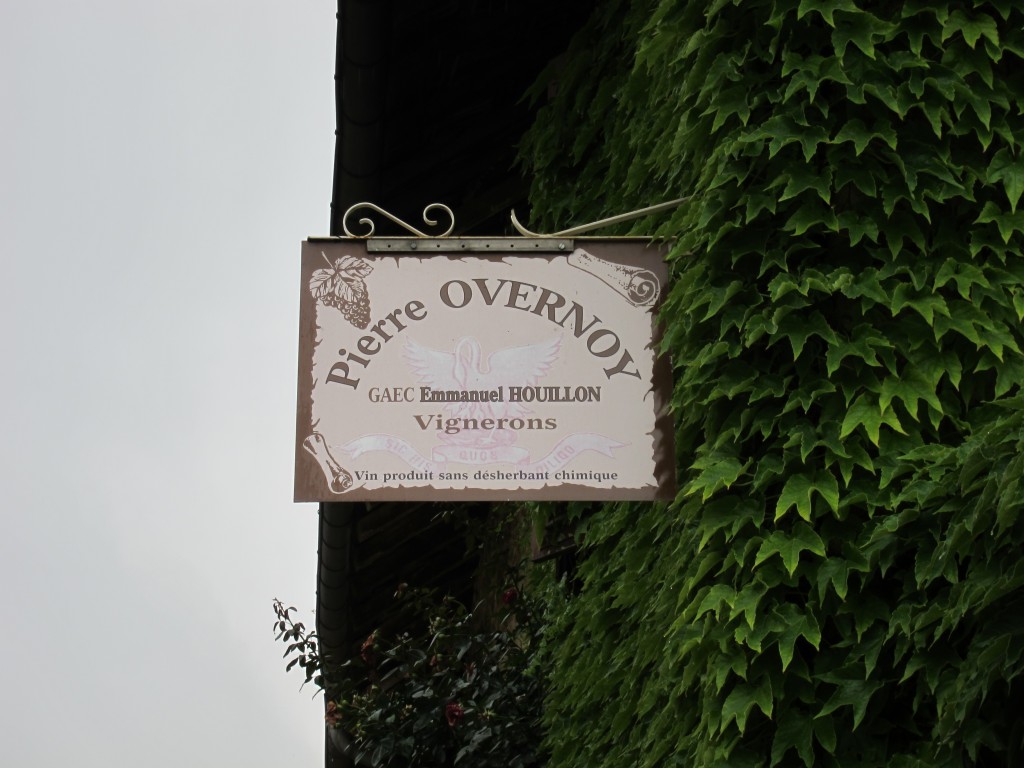 If you travel to Jura, one of the hotbeds of natural winemaking, you’ll see a sign hanging above Overnoy’s doorway in Pupillin. It doesn’t make any bold ideological statements, with its only statement being “Vin produit sans désherbant chimique” (wine made without the use of any chemical herbicide), even as there is much more going on. Just like Lapierre, Overnoy isn’t a man for grand statements – and he wasn’t averse to a little chaptalization, if a bad vintage required it.
If you travel to Jura, one of the hotbeds of natural winemaking, you’ll see a sign hanging above Overnoy’s doorway in Pupillin. It doesn’t make any bold ideological statements, with its only statement being “Vin produit sans désherbant chimique” (wine made without the use of any chemical herbicide), even as there is much more going on. Just like Lapierre, Overnoy isn’t a man for grand statements – and he wasn’t averse to a little chaptalization, if a bad vintage required it.
This distance between the ideological bickering and name-calling and the practice of natural wine can probably be attributed to one thing in particular: taste. Indeed, the driving force behind a lot of natural winemakers’ adherence to this philosophy seems to be a very personal wish to make wine more to their personal liking.. In Jancis Robinson’s recent column, Thierry Puzelat says that he simply started on this path to make wines he liked to taste, a story also told by the Beaujolais winemakers, among others.
Lapierre recalled how, in the early 1970s, when he began making wine in the way he had learned it in oenology school, with cultured yeasts and sulfur and such, his father would frown when tasting the wine. “It’s how it’s supposed to be made”, Lapierre would say to his father, who had traditionally made the wine without sulfur or any addition. “I know, but it’s not good”, his father would reply. Lapierre eventually concluded the same thing, and dropped the modern approach in the early 80s. As a result, he told me, several producers from his neck of the woods would periodically drop by to drink his wine, telling him they just couldn’t drink the stuff they were making with cultured yeasts and other modern methods.
When I asked Gilles Bley of Clos Siguier, a producer of refreshing, no-sulfur Cahors, why he didn’t use new oak, he simply and gently replied: “I just don’t like the taste.” As for no sulfur, he expressed that it was the way he knew how to make wine, and that you just had to be careful In handling the wine gently and protecting it well from oxidation. No tirades, no big statements, just a question of making wine the way you like to taste it.
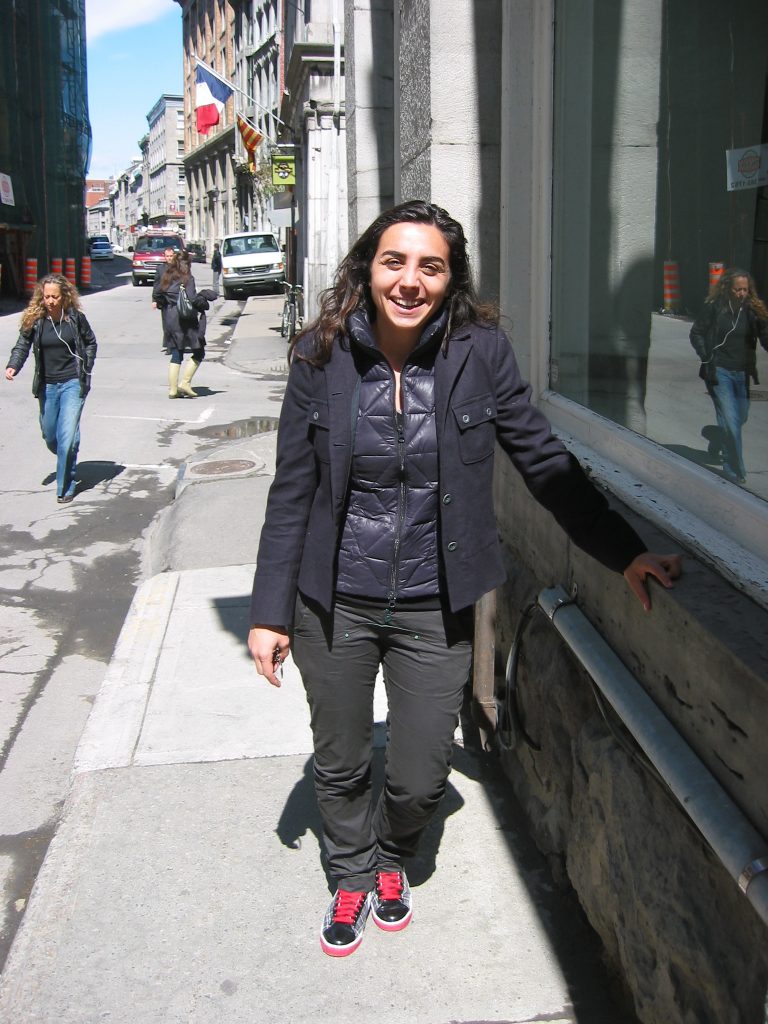
- Arianna Occhipinti
Discussing her remarkable and idiosyncratic Il Frappato, Sicilian natural wine producer Arianna Occhipinti explained that 30% of the wine, for the 2007 vintage, had stayed on its skins for eight months, instead of being pressed off early on, as one usually does. Why so long, I asked? “I kept tasting the wine and it kept tasting better and better”, she said, adding that she might or might not do it again, all depending on what she tasted. “I’m not thinking about the consumer when I make my wine”, she also said. “I just think it should be a mirror of the terroir – and I’m lucky to have very nice terroir.”
It’s the same kind of answer I also got from Jared Brandt, of A Donkey and Goat Winery, in Berkeley, who have been increasingly moving to no-sulfur wine, and actually published a manifesto on their natural approach to wine. When I visited them in late 2008, we tasted two versions of their superb grenache rosé, Isabel’s Cuvée, one that had been bottled with an addition of sulfur just prior to bottling, and the other one manually bottled without sulfur. The no-sulfur version definitely tasted fresher, with a brighter expression, encouraging him to move towards reducing the use of sulfur – notably in Isabel’s Crazy Cuvée, the no-sulfur version of the Grenache rosé. Already concentrating exclusively on natural fermentations, Jared and Tracey Brandt are actually looking to make more no-sulfur wines as time goes by.
An ounce of prevention
One of the key elements of natural winemaking is simply summarized in one word: prevention. Since you are not being chemically remedial, since you are not adding or removing stuff, you need to exert extra care at every step.
Successful natural winemakers tend to be very empirical, and reducing their approach to tradition non-intervention and “wild” things happening in the cellar is simply wrong. For instance, by using the services of a microbiologist, Lapierre and his colleagues learned that a traditional approach meant to solve a problem actually made it worse, and adjusted accordingly. Traditional wisdom said that, in warm years, you should pour juice over the fermenting bunches of grapes (Beaujolais fermentation is usually whole-bunch fermentation) to reduce the risk of lactic bacteria taking over and causing the wine to spoil. But as the microbiologist they hired looked through the microscope, she saw that the process actually increased the bacterial activity. Through this observation, they changed their procedure—notably by keeping the grapes at a cooler temperature—and helped reduce the prevalence of the problem.
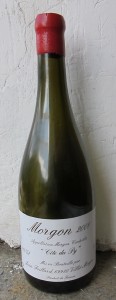
- A bottle of healthy, no-sulfur Morgon Côte du Py by Jean Foillard
Prevention is also why minimal sulfur at bottling is one of the most frequent additions that natural winemakers consent to, when necessary. Marcel Lapierre only sent sulfured bottlings to certain destinations like the Caribbean, where the high heat and difficulties in storage would make life exceedingly hard for his non-sulfured bottlings.
Jean Foillard, discussing the care that must be taken at the time of bottling (including, if possible, a look through the microscope to see what’s floating around), remembered an old vines cuvée that smelled and tasted so amazing that “I bottled it without checking, figuring the wine was so good that nothing could happen to it. But there was a bacteria present that causes what we call la maladie de l’amer, a breakdown that gives the wine a very bitter taste. After a few months, we realized we had to throw out the whole lot. And all that could have been taken care of with probably as little as 20 parts per million of sulfur.”
Despite these occasional problems, these winemakers remain committed to this goal of avoiding sulfur (and every other addition). If anything, the occasional mistake just teaches them to be even more careful and preventive and systematic in their approach.
Not everyone can be natural
One other point that natural winemakers have repeatedly said in discussions I had with them is that natural winemaking works on a small scale, and that while most of them hope to make converts, they do not see the whole world of wine heading that way. The Beaujolais winemakers were all unanimous in saying that they could hardly see anyone working in a natural, no-sulfur approach in estates larger than 15 to 20 hectares (40 to 50 acres, roughly). Controlling fermentations in a 20,000 liter tank simply can’t be done the same way as with a 500- or 1000-liter tank, they pointed out.
Far from condemning all large-scale producers, Lapierre simply recognized that they were doing something completely different. Lapierre had good words for Georges Duboeuf, the négociant who did so much, at a certain time, to raise standards and provide greater visibility and market share for Beaujolais wines. He appreciates the quality of Duboeuf wines—within the framework of a large-scale négociant. It’s just a different line of work, he said: “Doing what we do, for a négociant like Duboeuf, would be impossible. You shouldn’t oppose those two worlds of wine, they coexist. We make niche products, largely for a clientele that has the culture and money to appreciate them.”
Beyond scale, natural winemaking also depends on personal capacity and commitment. “It’s a lot more work”, insists Agnès Foillard, explaining why a lot of vignerons hesitate to take that route. “I don’t think everyone can do it. It’s a very serious thing”, concurs Arianna Occhipinti. “I like that the movement is growing. I think we should be very open—but also very serious.”
Respect for those who do things differently, a will to be open without letting everything and anything being included in the movement, principles to guide wine growing and winemaking, yet pragmatism as to how those principles should be applied: not all is black and white, in the “continuum of naturalness” that is modern winemaking, as Jamie Goode calls it. Most vignerons who work the “nothing added, nothing taken out” way are quite aware of this, and don’t dream of no-sulfur hegemony. Maybe everyone should take a deep breath, and a big sip of good wine. Natural, if you so choose.
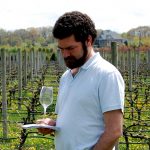 Rémy Charest is a Quebec City based journalist, writer, and translator. He has been writing about wine and food for over 12 years in various magazines and newspapers. He writes two wine blogs (The Wine Case, in English, and À chacun sa bouteille, in French) and, as if he didn’t have enough things to do, he recently started a food blog called The Food Case.
Rémy Charest is a Quebec City based journalist, writer, and translator. He has been writing about wine and food for over 12 years in various magazines and newspapers. He writes two wine blogs (The Wine Case, in English, and À chacun sa bouteille, in French) and, as if he didn’t have enough things to do, he recently started a food blog called The Food Case.
Related articles
- Saying Goodbye to Marcel Lapierre (palatepress.com)

